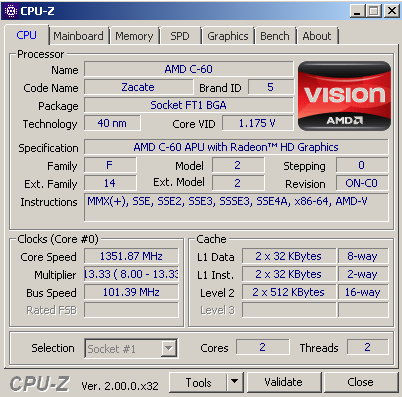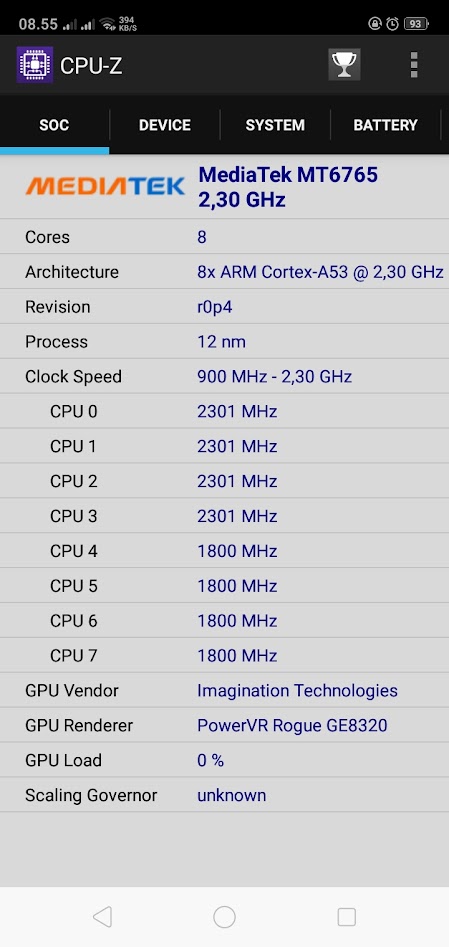Comparing: AMD C-60 vs MediaTek MT6765 Helio P35
In this comparison, we analyze two Processors: AMD C-60 and MediaTek MT6765 Helio P35, using synthetic benchmark tests to evaluate their overall performance. This side-by-side comparison helps users understand which hardware delivers better value, speed, and efficiency based on standardized testing. Whether you're building a new system or upgrading an existing one, this benchmark-driven evaluation offers valuable insights to guide your decision.

MediaTek MT6765 Helio P35
| Type: | Processors |
|---|---|
| Brand: | MediaTek |
| Model: | MediaTek MT6765 |
Specification Comparison Table
This specification comparison presents technical details of several devices or components to help you understand the key differences between each option. Use this table as a reference to determine which device best suits your needs.
| Specification | AMD C-60 | MediaTek MT6765 Helio P35 |
|---|---|---|
| Architecture | x86 | ARM |
| Technology | 40 nm | 12 nm |
| Clock | 1 GHz - 1.3 GHz | 1.8 GHz - 2.3 GHz |
| Core/Thread | 2 / 2 | 8 / 8 |
| Segmen | Mobile | Mobile |
Submission Comparison Table
This submission comparison table displays the number and details of benchmark data submissions from various devices or components. This information helps you understand the performance based on the benchmarks that have been tested, as well as providing an overview of the consistency and popularity of the available benchmark results.
Submission Comparison Chart
This chart visualizes the benchmark scores comparison between two hardware devices based on submitted data.
Media Gallery
A collection of photos of tested hardware. These images can help you identify the physical form, model, and variant of the hardware in question. These photos are from our own documentation, and if they are not available we may not be able to document them.
About Hardware AMD C-60
Released in 2011, the AMD C-60 is a power-efficient processor from the Ontario series built on the Bobcat architecture. It has 2 cores and 2 threads, with a base speed of 1.0 GHz that can be increased to 1.33 GHz through Turbo Core technology. Designed specifically for portable devices such as netbooks and ultraportable laptops, the C-60 is focused on power efficiency and long battery life rather than high performance. With a TDP of just 9 watts, this processor enables ultra-thin and lightweight laptop designs without the need for complex active cooling systems. The main advantage of the C-60 is its extremely low power consumption, making it an attractive solution for users who need a lightweight computing device for daily activities with high mobility.
The AMD C-60 is also equipped with an integrated Radeon HD 6290 GPU, which has 80 shader cores and supports DirectX 11. Despite its modest specifications, this GPU is sufficient for multimedia purposes such as HD video playback, light graphics rendering, and old-school games with minimal graphics settings. However, overall, the performance of the AMD C-60 is limited and only suitable for light tasks such as browsing, typing documents, and using basic office applications. This processor will feel slow when used for heavy multitasking, modern software installation, or complex web-based applications. In tests using an Acer Aspire One 522 paired with 2GB DDR3 RAM and Windows 7 operating system, the processor was able to provide a decent user experience for basic needs, but was less responsive when compared to mainstream processors of the same generation. Even so, the AMD C-60 remains a viable solution for low-cost, power-efficient devices of its time.
Hardware Detail:
Device: Acer Aspire One 522
RAM: 2GB DDR3
OS: Windows 7
Friday, 08 April 2022 17:00:00 | Update: 1 month ago
About Hardware MediaTek MT6765 Helio P35
The MediaTek Helio P35 (MT6765) is a mid-range mobile processor introduced in 2018, designed to offer a balance between performance, efficiency, and affordability. It features eight ARM Cortex-A53 cores, all running at speeds of up to 2.3 GHz, allowing for decent multitasking and responsiveness in everyday applications.
Built using the more efficient 12nm fabrication process, the Helio P35 is a significant improvement over older chips like the MT6750 or MT6737, both in terms of power consumption and thermal performance. This makes it well-suited for entry-level and mid-range smartphones with tighter thermal and battery constraints.
For graphics, the SoC integrates the PowerVR GE8320 GPU, which supports Full HD+ displays and provides enough power for media consumption and light gaming. It also includes support for AI-enhanced features, such as image processing and face detection, though without a dedicated NPU, the AI performance is modest compared to higher-tier chipsets.
While the Helio P35 is not intended for high-performance gaming, it performs well for tasks like social media, video playback, camera use, and general app usage. However, more demanding 3D games will run only at low graphics settings with occasional frame drops.
Hardware Detail:
Devices: OPPO A5s & OPPO A15s.
Device Specifications: MediaTek MT6765, 3/32 (A5s), 4/64 (A15s), Android 8 (A5s), Android 10 (A15s).
Room Temperature: 30°C based on DHT11 Sensor.
* Note: The OPPO A15s was used in some tests due to compatibility issues with Android 8 on A5s in certain applications.
Sunday, 08 September 2019 11:02:46 | Update: 1 month ago




